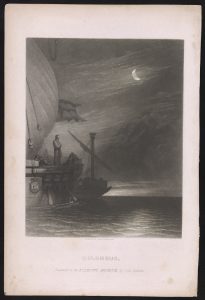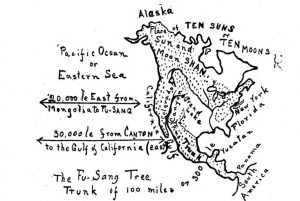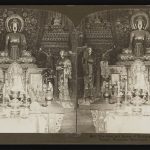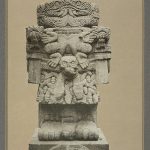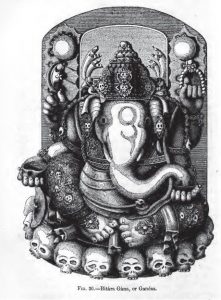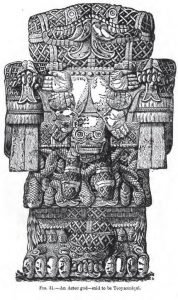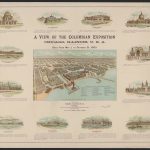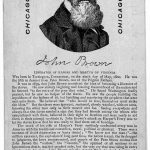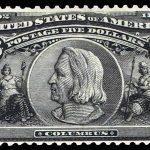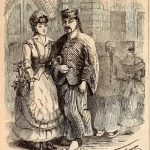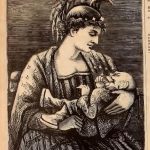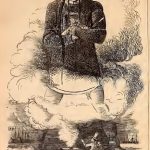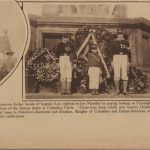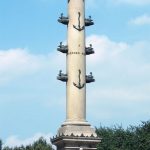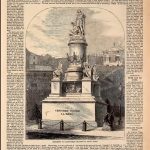150 years ago an article considered a logical conclusion: either the ancestors of the humans Christopher Columbus found in the Americas auto-generated (a second Adam and Eve), or Mr. Columbus and crew weren’t the first people from the Old World to discover the New.
From the September 18, 1869 issue of Harper’s Weekly:
THE DISCOVERY OF AMERICA BY THE CHINESE.
Was Columbus the first discoverer of America, or did he only rediscover that continent after it had, in remote ages, been found, peopled, and forgotten by the Old World? It is curious that this question has not been more generally raised, for it is very clear that one of two things must be true: either the people whom Columbus found in America must have been descended from emigrants from the Old World, and therefore America was known to the Old World before Columbus’s time, or else the aborigines of the western hemisphere were the result of spontaneous human generation – the development of man from a lower species of animal, or descended from a second Adam and Eve, whose origin would be equally puzzling. Unless we are prepared to cast aside Holy Writ, and all our general notions of the origin of the human race, we must believe that there was at one time communication between the Old World and the New. Probably this communication took place on the opposite side of the world to ours, between the eastern coast of Asia and the side of America most remote from Europe; and I believe it is quite possible that the inhabitants of Eastern Asia may have been aware of the existence of America, and kept up intercourse with it while our part of the Old World never dreamed of its existence. The impenetrable barrier the Chinese were always anxious to preserve between themselves and the rest of the nations of the Old World renders it quite possible that they should have kept their knowledge of America to themselves, or at any rate, from Europe. The objection that the art of navigation in such remote times was not sufficiently advanced to enable the Chinese to cross the Pacific and land on the western shore of America is not conclusive, as we have no found that arts and sciences which were once generally supposed to be of quite modern origin existed in China ages and ages before their discovery in Europe. The arts of paper-making and printing, among others, had been practiced in China long before Europeans had any idea of them. Why then should not the Chinese have been equally, or more, in advance of us in navigation? The stately ruins of Baalbec, with gigantic arches across the streets whose erection would puzzle our modern engineers, the Pyramids, and other remains of stupendous works point to a state of civilization, and the existence of arts and sciences in times of which European historians give no account.
One fact, corroborative of the idea that the Old World, or at least some of the inhabitants of Asia, were once aware of the existence of America before its discovery by Columbus is, that many of the Arabian ulema with whom I have conversed on this subject are fully convinced that the ancient Arabian geographers knew of America; and in support of this opinion point to passages in old works in which a country to the west of the Atlantic is spoken of. An Arab gentleman, a friend of mine, General Hussein Pasha, in a work he has just written on America, called En-Nessr-Et-Tayir, quotes from Djeldeki and other old writers to show this.
There is, however, among Chinese records not merely vague references to a country to the west of the Atlantic, but a circumstantial account of its discovery by the Chinese long before Columbus was born.
A competent authority on such matters, J. Haulay, the Chinese interpreter in San Francisco, has lately written an essay on this subject, from which we gather the following startling statements drawn from Chinese historians and geographers.
Fourteen hundred years ago even America had been discovered by the Chinese and described by them. They stated that land to be about 20,000 Chinese miles distant from China. About 500 years after the birth of Christ, Buddhist priests repaired there and brought back the news that they had met with Buddhist idols and religious writings in the country already. Their descriptions, in many respects, resemble those of the Spaniards a thousand years after. They called the country “Fusany,” after a tree which grew there, whose leaves resemble those of the bamboo, whose bark the natives made clothes and paper out of, and whose fruit they ate. These particulars correspond exactly and remarkably with those given by the American historian, Prescott, about the maquay tree in Mexico. He states that the Aztecs prepared a pulp for paper-making out of the bark of this tree. Then, even its leaves were used for thatching; its fibers for making ropes; its roots yielded a nourishing food; and its sap, by means of fermentation, was made into an intoxicating drink. he accounts given by the Chinese and Spaniards, although a thousand years apart, agree in stating that the natives did not possess any iron, but only copper; that they made all their tools, for working in stone and metals, out of a mixture of copper and tin; and they, in comparison with the nations of Europe and Asia, thought but little of the worth of silver and gold. The religious customs and forms of worship presented the same characteristics to the Chinese fourteen hundred years ago as to the Spaniards four hundred years ago. There is, moreover, a remarkable resemblance between the religions of the Aztecs and the Buddhism of the Chinese, as well as between the manners and customs of the Aztecs and those of the people of China. There is also a great similarity between the features of the Indian tribes of Middle and South America and those of the Chinese, and, as Haulay, the Chinese interpreter of whom we spoke above, states, between the accent and most of the monosyllabic words of the Chinese and Indian languages. Indeed, this writer gives a list of words which point to a close relationship; and infers therefrom that there must have been emigration from China to America at some remote period, that at the time of the discovery of America by the Spaniards the Indian tribes on the coast of the Pacific, opposite to China, for the most part, enjoyed a state of culture of ancient growth, while the inhabitants of the Atlantic shore were found by Europeans in a state of original barbarism. If the idea of America having been discovered before the time of Columbus be correct, it only goes to prove that there is nothing new under the sun; and that Shelly [sic] was right in his bold but beautiful lines – “Thou canst not find one spot whereon no city stood.” Admitting this, who can tell whether civilization did not exist in America when we were plunged in barbarism? and, stranger still, whether the endless march of ages in rolling over our present cultivation may not obliterate it, and sever the two hemispheres once again from each other’s cognizance? Possibly, man is destined, in striving after civilization, to be like Sisyphus, always engaged in rolling up a stone which ever falls down.
This exact same article showed up other places. For example, according to Google Books it was published in the Gentleman’s Magazine and Historical Chronicle, Volume 3 pages 333-335, apparently also published in 1869. The author is said to be Charles Wells
I’m in way over my head here, but it seems that the Chinese who were said to explore America about 500 AD were like Columbus – they found people who had “discovered” the New World well ahead of them. The map-diagram above was published in Ancient Chinese Account of the Grand Canyon, or Course of the Colorado by Alexander M’Allan (1913) (at Project Gutenberg); the book finds similarities between ancient Chinese accounts and American views of North America. Mr. M’Allan cites Edward P. Vining’s 1885 An inglorious Columbus, or, Evidence that Hwui Shăn and a Party of Buddhist Monks from Afghanistan Discovered America in the Fifth Century A.D. (at Project Hathi and the Internet Archive). Mr. Vining’s book includes on pages 612-613 a side-by-side comparison of the Javan elephant god Bitara Gana, or Ganesa and another look at the Aztec god Teoyaomiqui: “A comparison of the two will show many resemblances that the conclusion hardly seems far-fetched that the latter is merely a modification of the former, brought about by gradual changes, which have accumulated through many centuries.”
The books’s title page included this quote: “If Buddhist priests were really the first men who, -within the scope of written history and authentic annals, went from the Old World to the New, it will sooner or later be proved. Nothing can escape history that belongs to it.” – LELAND.
I don’t think it’s been proven, at least not yet. According to Wikipedia only the Norse colonization of Greenland and Newfoundland around the year 1000 A.D. is the only “historical case of pre-Columbian contact … widely accepted among the scientific and scholarly mainstream.” And
Scientific and scholarly responses to other claims of post-prehistory, pre-Columbian contact have varied. Some of these claims are examined in reputable peer-reviewed sources. Many others—especially those based on circumstantial or ambiguous interpretations of archaeological evidence, alleged out-of-place artifacts, superficial cultural comparisons, comments in historical documents, or narrative accounts—have been dismissed as fringe science, pseudoarchaeology, or pseudohistory.
The Wikipedia article mentions the Chinese Buddhist missionaries of Mr. Vining’s book. Another claim, that about 1000 years later Chinese Admiral Zheng He discovered America before Columbus has been debunked – apparently the claim was based on a fake map.
According to the July 9, 2015 online Daily Mail possibly ancient Chinese characters were discovered in the Southwest United States. “John Ruskamp, a retired chemist and amateur epigraph researcher from Illinois, discovered the unusual markings while walking in the Petroglyph National Monument in Albuquerque, New Mexico.” Mr. Ruskamp considered the find evidence of Chinese visitors to America about 1300 B.C.
What about the people who were already in America when all the possible visitors discovered it? I think the scientific consensus is that the first humans got to the Americas about 14,000 years ago by walking from what is now Siberia to modern-day Alaska over the Beringia land bridge, which was visible and usable because of lower sea levels at the time. These people spread throughout the Western Hemisphere. Some of the details could probably change due to scientific advances and/or the next find. For example, see an article at Sapiens:”Indeed, no tidy, new framework has arisen to take the place of older theories. Instead, new data, including genetic findings, continue to complicate the story of how these continents came to be peopled.”
The used U.S. history text I found at the library book sale began by saying that the ancestors of the modern native Americans came here tens of thousands years ago over the land bridge. But they didn’t realize they found anything new. Although Leif Erikson was the first European to find the Americas and Amerigo Vespucci is the New World’s namesake, the authors seem to have agreed that Columbus should be honored as the discoverer of America because his adventures “inspired the European invasion and the development of the whole area between Hudson Bay and the Strait of Magellan.” [1]
In 1893 Chicago hosted a World’s Columbian Exposition to commemorate the 400th anniversary of Christopher Columbus’s 1492 voyage. You can read all about it at Travalanche. The John Brown souvenir is a bit of a blue-gray connection.
The Chinese Buddhists and Zheng He might not have visited America, but in 1869 America was very aware of China, probably at least in part because of the Chinese Embassy in 1868 and all the Chinese workmen who helped build the Transcontinental Railroad.
Reader’s Digest reports that some U.S. states and cities no longer celebrate Columbus Day.
All the Harper’s Weekly material was published in 1869 (at the Internet Archive). You can find Marcel René Kalt alias Groovio’s photo of the Columbus statue at Wikimedia, which also has the stamp. From the Library of Congress: in 1843 John Sartain engraved J.M.W. Turner’s painting of Mr. Columbus looking for land;at the base of the Columbus statue on Manhattan; Buddhist altar c.1907 in Moukden (now Shenyang); Aztec idol Teoyaomiqui; the John Brown souvenir from Chicago’s World Columbian Exposition 1893; exposition overview
I added a couple links on October 16, 2019.
_______________________________
- [1]Garraty, John A., and Robert A. McCaughey. The American Nation: A History of the United States, Seventh Edition. New York: HarpersCollins Publishers, 1991. Print. page 1.↩

